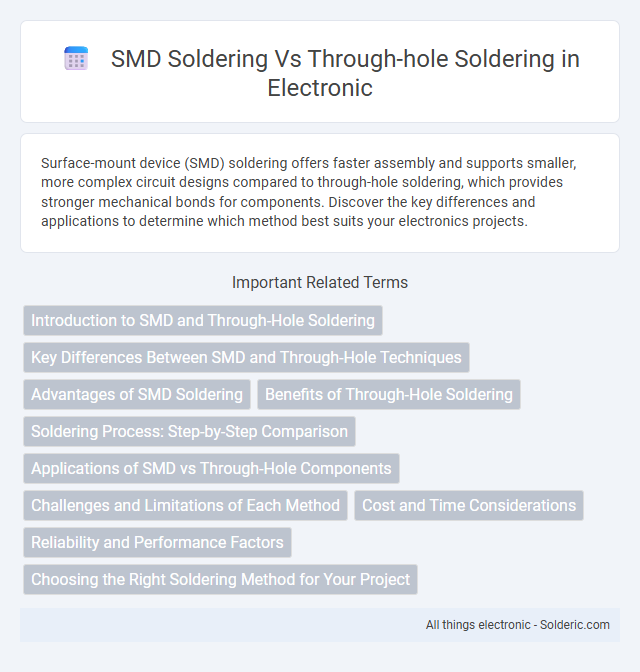Surface-mount device (SMD) soldering offers faster assembly and supports smaller, more complex circuit designs compared to through-hole soldering, which provides stronger mechanical bonds for components. Discover the key differences and applications to determine which method best suits your electronics projects.
Comparison Table
| Aspect | SMD Soldering | Through-Hole Soldering |
|---|---|---|
| Component Type | Surface-Mount Devices (SMD) | Leaded Components with Pins |
| Mounting Method | Placed directly on PCB surface pads | Pins inserted through PCB holes |
| Assembly Speed | Faster, automated pick-and-place | Slower, manual or machine insertion |
| Size | Smaller, compact design | Larger, bulkier components |
| Mechanical Strength | Less mechanical support | Stronger mechanical bonding |
| Repair and Rework | Challenging, requires specialized tools | Easier to rework and replace |
| Cost | Lower cost per unit due to automation | Higher manual labor costs |
| Thermal Performance | Better heat dissipation | Lower heat dissipation efficiency |
| Typical Applications | Modern electronics, smartphones, laptops | Power circuits, connectors, prototyping |
Introduction to SMD and Through-Hole Soldering
SMD soldering involves mounting electronic components directly onto the surface of a printed circuit board (PCB), offering advantages in miniaturization and automated assembly. Through-hole soldering requires inserting component leads into drilled holes on the PCB, providing stronger mechanical bonds for components subject to mechanical stress. Your choice between these techniques depends on the application requirements, board design, and manufacturing process.
Key Differences Between SMD and Through-Hole Techniques
SMD soldering involves mounting components directly onto the surface of printed circuit boards (PCBs), offering a more compact design and faster automated assembly compared to through-hole soldering, which requires inserting component leads through holes for mechanical stability. Through-hole soldering provides stronger physical connections, making it suitable for heavy or high-stress components, whereas SMD excels in high-density, lightweight electronics due to smaller component sizes. Your choice depends on factors like mechanical strength needs, board complexity, and production volume.
Advantages of SMD Soldering
SMD soldering offers significant advantages including smaller component size, allowing for higher circuit density and more compact device designs. Its automated assembly process increases production speed and consistency, reducing manufacturing costs and errors. You benefit from improved electrical performance and reliability due to shorter lead lengths and reduced parasitic inductance.
Benefits of Through-Hole Soldering
Through-hole soldering offers enhanced mechanical strength and durability, making it ideal for components subjected to physical stress or high temperatures. This method ensures more reliable electrical connections on double-sided or multi-layer PCBs, supporting robust circuit performance. Your projects benefit from easier inspection and repair, as through-hole components are more accessible for manual handling and troubleshooting.
Soldering Process: Step-by-Step Comparison
SMD soldering involves placing tiny surface-mount components directly onto PCB pads, followed by applying solder paste and reflow soldering in an oven for precise, automated connections. Through-hole soldering requires inserting component leads through drilled holes on the PCB, then manually or wave soldering to secure each lead, offering stronger mechanical bonds but slower assembly. Your choice between SMD and through-hole soldering affects assembly speed, automation level, and suitability for different component types.
Applications of SMD vs Through-Hole Components
SMD soldering is ideal for compact, high-density electronic devices like smartphones, laptops, and wearables due to its small footprint and automated assembly compatibility. Through-hole soldering is preferred in applications requiring robust mechanical strength and reliability, such as power supplies, automotive circuits, and industrial equipment. Your choice between SMD and through-hole components should align with the device's size constraints, durability demands, and production scalability.
Challenges and Limitations of Each Method
SMD soldering faces challenges with precise placement and the risk of thermal damage due to small pad sizes and high component density, complicating manual soldering efforts. Through-hole soldering offers stronger mechanical bonds but struggles with limitations in automated production and restrictions on circuit board density due to larger hole sizes. Both methods demand tailored equipment and skilled operators to address issues like solder bridging in SMD and hole misalignment in through-hole techniques.
Cost and Time Considerations
SMD soldering significantly reduces manufacturing costs by enabling automated assembly, which decreases labor expenses and minimizes material waste compared to the manual process required for through-hole soldering. The smaller size and higher component density of SMD components allow faster placement and soldering cycles, accelerating production time. Through-hole soldering demands more time due to manual insertion and longer reflow processes, increasing overall labor costs and limiting production speed.
Reliability and Performance Factors
SMD soldering offers higher reliability and performance due to smaller component size and reduced lead inductance, which enhance signal integrity and heat dissipation. Through-hole soldering provides mechanical strength ideal for high-stress environments but may suffer from increased parasitic effects impacting high-frequency performance. Your choice depends on balancing mechanical durability with electrical efficiency for optimal device reliability.
Choosing the Right Soldering Method for Your Project
Choosing between SMD soldering and through-hole soldering depends on factors such as component size, board complexity, and production volume. SMD soldering is ideal for compact, high-density circuit designs requiring automated assembly and precise placement, while through-hole soldering offers stronger mechanical bonds suitable for components subjected to mechanical stress or manual prototyping. Evaluating project specifications and device requirements ensures optimal soldering method selection for reliability and performance.
SMD soldering vs through-hole soldering Infographic

 solderic.com
solderic.com